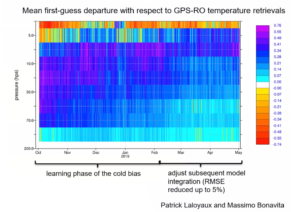Just a few months ago, a series of major new weather and climate supercomputing investments were announced, including a £1.2 billion order for the world’s most powerful weather and climate supercomputer and a tripling of the U.S.’ operational supercomputing capacity for weather forecasting. Weather and climate modeling are among the most power-hungry use cases for supercomputers, and research and forecasting agencies often struggle to keep up with the computing needs of models that are, in many cases, simulating the atmosphere of the entire planet as granularly – and as regularly – as possible.
What if that all changed?
 In a virtual keynote for the HPC-AI Advisory Council’s 2020 Stanford Conference, Peter Dueben outlined how machine learning might (or might not) begin to augment – and even, eventually, compete with – heavy-duty, supercomputer-powered climate models. Dueben is the coordinator for machine learning and AI activities at the European Centre for Medium-Range Weather Forecasts (ECMWF), a UK-based intergovernmental organization that houses two supercomputers and provides 24/7 operational weather services at several timescales. ECMWF is also the home of the Integrated Forecast System (IFS), which Dueben says is “probably one of the best forecast models in the world.”
In a virtual keynote for the HPC-AI Advisory Council’s 2020 Stanford Conference, Peter Dueben outlined how machine learning might (or might not) begin to augment – and even, eventually, compete with – heavy-duty, supercomputer-powered climate models. Dueben is the coordinator for machine learning and AI activities at the European Centre for Medium-Range Weather Forecasts (ECMWF), a UK-based intergovernmental organization that houses two supercomputers and provides 24/7 operational weather services at several timescales. ECMWF is also the home of the Integrated Forecast System (IFS), which Dueben says is “probably one of the best forecast models in the world.”
Why machine learning at all?
The Earth, Dueben explained, is big. So big, in fact, that apart from being laborious, developing a representational model of the Earth’s weather and climate systems brick-by-brick isn’t achieving the accuracy that you might imagine. Despite the computing firepower behind weather forecasting, most models remain at a 10 kilometer resolution that doesn’t represent clouds, and the chaotic atmospheric dynamics and occasionally opaque interactions further complicate model outputs.
“However, on the other side, we have a huge number of observations,” Dueben said. “Just to give you an impression, ECMWF is getting hundreds of millions of observations onto the site every day. Some observations come from satellites, planes, ships, ground measurements, balloons…” This data – collected over the last several decades – constituted hundreds of petabytes if simulations and climate modeling results were included.
“If you combine those two points, we have a very complex nonlinear system and we also have a lot of data,” he said. “There’s obviously lots of potential applications for machine learning in weather modeling.”
Potential applications of machine learning
“Machine learning applications are really spread all over the entire workflow of weather prediction,” Dueben said, breaking that workflow down into observations, data assimilation, numerical weather forecasting, and post-processing and dissemination. Across those areas, he explained, machine learning could be used for anything from weather data monitoring to learning the underlying equations of atmospheric motions.
By way of example, Dueben highlighted a handful of current, real-world applications. In one case, researchers had applied machine learning to detecting wildfires caused by lightning. Using observations for 15 variables (such as temperature, soil moisture and vegetation cover), the researchers constructed a machine learning-based decision tree to assess whether or not satellite observations included wildfires. The team achieved an accuracy of 77 percent – which, Deuben said, “doesn’t sound too great in principle,” but was actually “quite good.”
Elsewhere, another team explored the use of machine learning to correct persistent biases in forecast model results. Dueben explained that researchers were examining the use of a “weak constraint” machine learning algorithm (in this case, 4D-Var), “which is a kind of algorithm that would be able to learn this kind of forecast error and correct it in the data assimilation process.”

“We learn, basically, the bias,” he said, “and then once we have learned the bias, we can correct the bias of the forecast model by just adding forcing terms to the system.” Once 4D-Var was implemented on a sample of forecast model results, the biases were ameliorated. Though Dueben cautioned that the process is “still fairly simplistic,” a new collaboration with Nvidia is looking into more sophisticated ways of correcting those forecast errors with machine learning.
Dueben also outlined applications in post-processing. Much of modern weather forecasting focuses on ensemble methods, where a model is run many times to obtain a spread of possible scenarios – and as a result, probabilities of various outcomes. “We investigate whether we can correct the ensemble spread calculated from a small number of ensemble members via deep learning,” Dueben said. Once again, machine learning – when applied to a ten-member ensemble looking at temperatures in Europe – improved the results, reducing error in temperature spreads.
Can machine learning replace core functionality – or even the entire forecast system?
“One of the things that we’re looking into is the emulation of different permutation schemes,” Dueben said. Chief among those, at least initially, have been the radiation component of forecast models, which account for the fluxes of solar radiation between the ground, the clouds and the upper atmosphere. As a trial run, Dueben and his colleagues are using extensive radiation output data from a forecast model to train a neural network. “First of all, it’s very, very light,” Dueben said. “Second of all, it’s also going to be much more portable. Once we represent radiation with a deep neural network, you can basically port it to whatever hardware you want.”
Showing a pair of output images, one from the machine learning model and one from the forecast model, Dueben pointed out that it was hard to notice significant differences – and even refused to tell the audience which was which. Furthermore, he said, the model had achieved around a tenfold speedup. (“I’m quite confident that it will actually be much better than a factor of ten,” Dueben said.)

Dueben and his colleagues have also scaled their tests up to more ambitious realms. They pulled hourly data on geopotential height (Z500) – which is related to air pressure – and trained a deep learning model to predict future changes in Z500 across the globe using only that historical data. “For this, no physical understanding is really required,” Dueben said, “and it turns out that it’s actually working quite well.”
Still, Dueben forced himself to face the crucial question.
“Is this the future?” he asked. “I have to say it’s probably not.”
There were several reasons for this. First, Dueben said, the simulations were unstable, eventually “blowing up” if they were stretched too far. “Second of all,” he said, “it’s also unknown how to increase complexity at this stage. We only have one field here.” Finally, he explained, there were only forty years of sufficiently detailed data with which to work.
Still, it wasn’t all pessimism. “It’s kind of unlikely that it’s going to fly and basically feed operational forecasting at one point,” he said. “However, having said this, there are now a number of papers coming out … where people are looking into this in a much, much more complicated way than we have done with really sophisticated convolutional networks … and they get, actually, quite good results. So who knows!”
The path forward
“The main challenge for machine learning in the community that we’re facing at the moment,” Dueben said, “is basically that we need to prove now that machine learning solutions can really be better than conventional tools – and we need to do this in the next couple of years.”
There are, of course, many roadblocks to that goal. Forecasting models are extraordinarily complicated; iterations on deep learning models require significant HPC resources to test and validate; and metrics of comparison among models are unclear. Dueben also outlined a series of major unknowns in machine learning for weather forecasting: could our explicit knowledge of atmospheric mechanisms be used to improve a machine learning forecast? Could researchers guarantee reproducibility? Could the tools be scaled effectively to HPC? The list went on.
“Many scientists are working on these dilemmas as we speak,” Dueben said, “and I’m sure we will have an enormous amount of progress in the next couple of years.” Outlining a path forward, Dueben emphasized a “mixture of a top-down and a bottom-up approach to link machine learning with weather and climate models.” Per his diagram, this would combine neutral networks based on human knowledge of earth systems with reliable benchmarks, scalability and better uncertainty quantification.
As far as where he sees machine learning for weather prediction in ten years?
“It could be that machine learning will have no long-term effect whatsoever – that it’s just a wave going through,” Dueben mused. “But on the other hand, it could well be that machine learning tools will actually replace almost all conventional models that we’re working with.”


























































